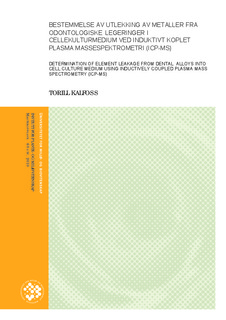Bestemmelse av utlekking av metaller fra odontologiske legeringer i cellekulturmedium ved induktivt koplet plasma massespektrometri (ICP-MS)
Master thesis
Permanent lenke
http://hdl.handle.net/11250/189292Utgivelsesdato
2010-11-15Metadata
Vis full innførselSamlinger
- Master's theses (IPM) [204]
Sammendrag
Det finnes over tusen odontologiske legeringer på markedet i dag, og bruken av uedle legeringer har i stor grad erstattet bruken av gullbaserte legeringer. Felles for disse legeringene er at de er i kontakt med oralt vev, og at metaller lekker fra legeringene ut i munnhulen. Det stilles derfor mange spørsmål om den biologiske sikkerheten omkring bruken av disse legeringene. Korrosjonstester, hvor de ulike legeringene blir utsatt for det samme
sure miljøet som finnes i munnhulen, har vist at uedle legeringer lekker ut større
konsentrasjoner av metaller sammenlignet med edle legeringer Nordisk Institutt for Odontologiske Materialer (NIOM) har undersøkt ekstrakter av ulike legeringer i cellekulturer og sett på hvilken påvirkning de har på cellene. I den sammenheng
ønsket de å kvantifisere utlekking av metaller fra de ulike legeringene i cellekulturmediet for å bestemme konsentrasjonen av de ulike grunnstoffene som cellene hadde blitt utsatt for.
Fürst Medisinsk Laboratorium fikk i oppdrag å utvikle en metode for kvantitativ bestemmelse av grunnstoffer i Minimal Essential Medium with Earle’s salts (MEM).
Atten ulike odontologiske legeringer, hovedsakelig uedle, ble sandlåst, slipt og renset før inkubering i MEM cellekulturmedium under bevegelse i tre døgn ved 37 C. Legeringene ble deretter fjernet fra mediet og løsningene ble analysert ved induktivt koplet plasma
massespektrometri (ICP-MS). Alle prøvene ble analysert for grunnstoffene litium (Li),
beryllium (Be), aluminium (Al), vanadium (V), mangan (Mn), kobolt (Co), nikkel (Ni),
kobber (Cu), sink (Zn), gallium (Ga), arsen (As), selen (Se), rubidium (Rb), strontium (Sr), yttrium (Y), zirkonium (Zr), niob (Nb), molybden (Mo), ruthenium (Ru), palladium (Pd), sølv (Ag), kadmium (Cd), indium (In), tinn (Sn), antimon (Sb), cesium (Cs), barium (Ba), lantan (La), cerium (Ce), praseodym (Pr), neodym (Nd), samarium (Sm), europium (Eu), gadolinium (Gd), terbium (Tb), dysprosium (Dy), holmium (Ho), erbium (Er), thulium (Tm), ytterbium (Yb), lutetium (Lu), hafnium (Hf), tantal (Ta), wolfram (W), rhenium (Re), osmium (Os), iridium (Ir), platina (Pt), gull (Au), bly (Pb), vismut (Bi) og thorium (Th). Resultater fra analysering av de odontologiske legeringene viste bare utlekking av de metallene som var oppgitt fra produsenten av legeringene, og det er kun disse grunnstoffene som er presentert i
resultatkapittelet. Som korrosjonstestene gav også her de uedle legeringene et høyere utslipp av metaller enn de edle legeringene. 3 Målemetoden som ble utviklet på ICP-MS gav tifredsstillende deteksjons- og kvantifiseringsgrenser, gjenfinning, presisjon og nøyaktighet for grunnstoffene Cr, Mn, Co, Ni, Cu, Zn, Ga, Nb, Mo, In, Sn, W, Pt og Au. Metoden gav bare ca 80 % gjenfinning av Ag
og den kunne ikke brukes for bestemmelse av Pd < 50 μg/L. Metoden hadde ikke tilstrekkelig sensitivitet for bestemmelse av Fe på det nivået som lakk fra de 18 legeringene som ble analysert i denne oppgaven. Den største usikkerheten i metoden lå i prepareringen av
løsningene. For mye manipulering av noen av legeringene ødela det beskyttende oksidlaget som ble dannet på overflaten og økte dermed utlekking av metaller. There are more than a thousand dental alloys on the market today, and non precious alloys
have replaced the use of gold - containing alloys. Dental alloys are in contact with oral
tissues, and consequently metals leak into the mouth. There are a lot of questions about the biological safety of using these alloys. Corrosion tests have shown that there are significantly higher amount of leakage from non precious alloys, compared to precious alloys. Nordisk Institutt for Odontologiske Materialer (NIOM) has investigated the influence of the metals from different alloys on cells in cell cultures. Their aim has been to quantify the amount of metal leakage from the alloys into the cell culture medium to determine the concentrations of different elements that cells become exposed to. Fürst Medisinsk Laboratorium was asked to develop a method for quantita Minimal Essential Medium with Earle’s salts (MEM).
Eighteen different dental alloys, mainly non precious, were sandblasted, polished and cleaned before incubation in MEM cell culture medium under agitation at 37 C for 72 hours. The specimens were then removed, and the solutions were analyzed by inductively coupled plasma mass spectrometry (ICP-MS). The elements Li, Be, Al, V, Mn, Co, Ni, Cu, Zn, Ga, As, Se, Rb, Sr, Y, Zr, Nb, Mo, Ru, Pd, Ag, Cd, In, Sn, Sb, Cs, Ba, La, Ce, Pr, Nd, Sm, Eu, Gd, Tb, Dy, Ho, Er, Tm, Yb, Lu, Hf, Ta, W, Re, Os, Ir, Pt, Au, Pb, Bi and Th were identified and quantified. The released and detected elements were in accordance with the composition stated for the different alloys, and only these elements are presented in the results chapter. The leakage was higher from non precious alloys compared to precious alloys. The limits of detection, limits of quantification, recoveries, precision and accuracy of the method were sufficient and satisfactory for the elements Cr, Mn, Co, Ni, Cu, Zn, Ga, Nb, Mo, In, Sn W, Pt and Au. The method had only 80 % recovery of Ag, and it could not be used for
determination of Pd < 50 μg/L. The method was not sensitive enough to quantify Fe leakage from the dental alloys investigated in this project. The biggest uncertainty was in preparation of the solutions. The protective oxidation layer on the surface of the alloys of some samples was destroyed by artificial heavy handling.
